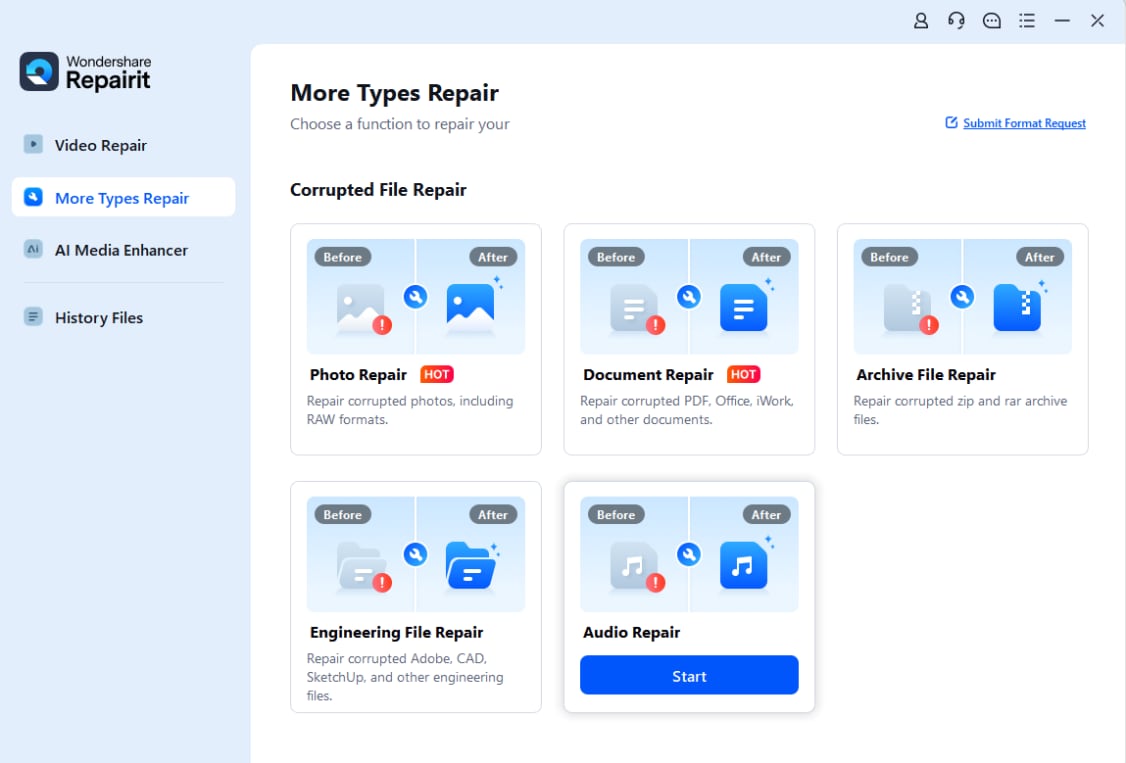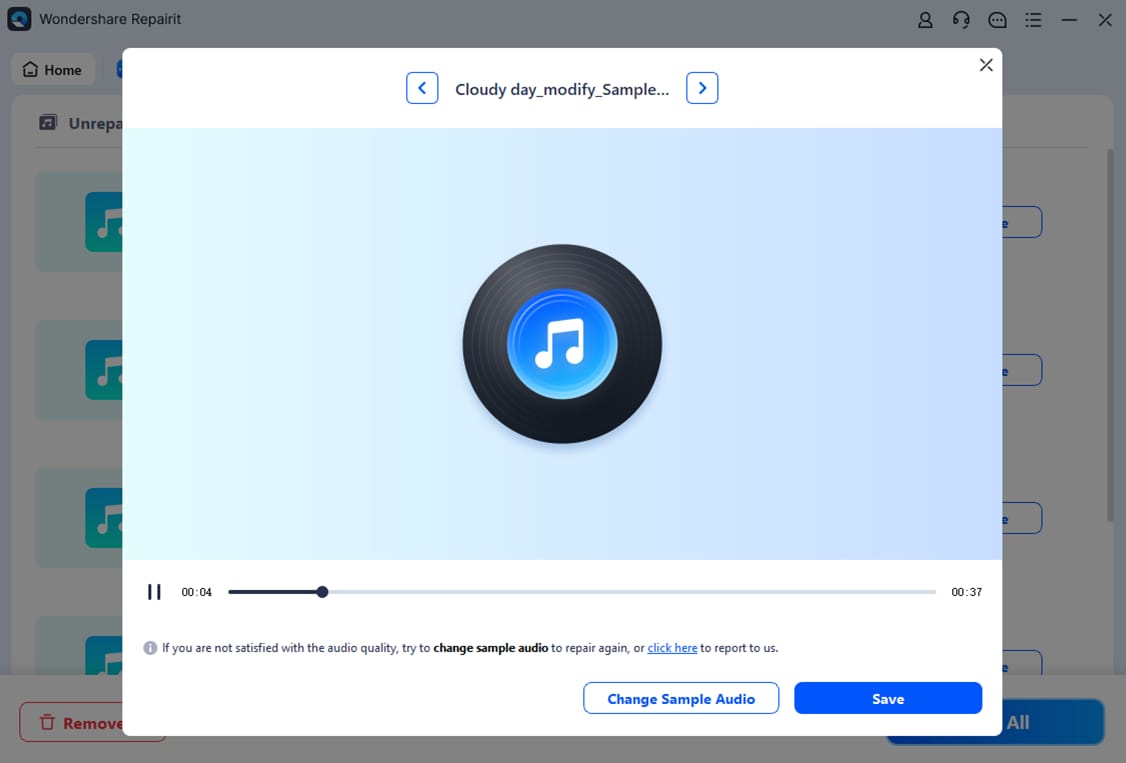Fix "No Audio Devices Are Installed" problem
Check why the "no audio output device is installed" error occurs and the methods to fix the error, as well as the details to fix corrupted audio with Repairit - Audio Repair with clicks.
Imagine opening your laptop and seeing a red cross on the speaker icon — no sound at all. This is the common 'no audio output device is installed' error, which is based on the errors across the output devices.
This article is set to discuss the specific error and provide users with an in-depth insight into how a user can resolve the existing problem without any audio devices being installed.
Part 1: What Does This Error Message Mean?
Are you finding yourselves entangled in the error of "no output devices found" while connecting your computer to speakers? The error means that the user cannot listen to any sound created on the computer through the platform or file.
To understand more about this error on your computer, you will find the "Red Cross" button on the taskbar against the "Speaker" icon. This means that no audio output devices are present across the computer that can be used to hear the sound across it. Considering you run into this issue, it is equally essential for you to be aware of how this error occurs across your computer:
- Playback Device Disabled: There might be a case where you may have tried to attach another sound device to the computer, disabling your current playback device. In such circumstances, when you try listening through the current playback device, you won't hear any sound out of it. Therefore, it's possible for you to have a disabled playback device on your Windows computer.
- Wrong Port Connection: Considering you have been trying to attach an external sound device to the computer, you may be trying to attach it through the wrong port, which creates a non-functional output device with no audio.
- Windows Update Bugs: Your Windows computer may have gone through a recent update, which may have brought certain bugs and glitches across your device and directly damaged your output sound device. In such cases, you need to check if the error directly comes through the Windows update.
- Outdated or Unavailable Drivers: The drivers installed across the Windows computer may have been outdated, or there may be additional drivers hindering the process of the other drivers operating the original sound.
- Bluetooth Connectivity Issues: If you're trying to connect a wireless device to the computer through Bluetooth, check whether the Bluetooth is operating across the device with no errors. Improper pairing can lead to inappropriate cases where there won't be any detected devices across the computer.
Part 2: Let's Fix No Audio Output Device is Installed
We shall now look ahead to some of the perfect fixes that can be used to figure out a proper solution to the error involving the installation of audio output devices. You can indeed set the audio output of your computer right with the help of these helpful solutions.
Table of Contents
Fix 1: Update the Sound Driver
Starting with one of the significant reasons that may cause the audio output device installation problem on your Windows computer, we shall look into the details of how a user can update the sound driver that is malfunctioning due to being outdated. For this, we shall look into the detailed steps for updating the sound driver as follows:
Step 1: Open the "Device Manager" from the "Search" bar on the taskbar.
Lead into the "Sound, video, and game controllers" section and locate the sound driver you have to update.

Step 2: Right-click on the driver and select the option "Update driver/device."
On the following screen, follow the process of automatically searching and updating the drivers of the sound device.

Fix 2: Use Audio Troubleshooter
Looking further into the issue of installing audio device failure across your Windows computer, we shall now turn to another impressive technique. Using an audio troubleshooter will help you efficiently fix all issues that the user across the computer cannot detect. To understand how you can efficiently use this on your Windows computer, look ahead into the steps:
Step 1: Start by using the shortcut keys of "Windows + I" to open the "Settings" of your Windows computer.
Click on the "Update & Security" section from the options available on the screen.

Step 2: On the window that opens up, locate the "Troubleshoot" tab.
And find the "Additional Troubleshooters" option from the list of options available on the screen.

Step 3: As you get into a new screen, find the "Playing Audio" troubleshooter from the list.
And click on the "Run the troubleshooter" button against it to start the troubleshooter.

Fix 3: Uninstall and Reinstall Your Device's Driver
If you find that the issue remains across the drivers of the sound device installed on the computer and has not been resolved by getting updated, you will need to uninstall and reinstall the sound drivers. To carry this out, we have presented a simple step-by-step procedure that needs to be covered as follows:
Step 1: Start the process by clicking on the "Search" button present on the taskbar of your Windows computer.
Type in "Device Manager" and open it in a new window.

Step 2: Across the screen, locate the "Sound, video and game controllers" section.
And right-click on the driver to select the option of "Uninstall driver/device" from the protruding menu. Follow the on-screen instructions to uninstall the driver completely from your computer.

Step 3: Then, return to the Device Manager.
And right-click on the Desktop option to select the option "Scan for hardware changes."

Fix 4: Disconnect and Reconnect the External Output Device
This is a quick method you can try to resolve the issue with audio device installation on your computer. Since you are connecting an external output device to your computer, problems exist within the connections that are used to interact between the two devices. This may lead to no detection of the output device, bringing the conditions to such a point.
Fix 5: Use Add Legacy Hardware Option
There might be a chance that the device you are connecting to the Windows computer may be outdated and older, preventing the computer from automatically detecting drivers for installation. As this turns out to be the main hindrance to getting the audio device installed, you need to access the Add Legacy Hardware option across your computer through the Device Manager.
Step 1: Tap the "Search" icon on the taskbar.
And type in "Device Manager" to open it on a new screen.

Step 2: Following this, lead to the "Sound, video and game controllers" section and double-click on it.
Then, you need to access the "Action" tab at the top and select the option "Add legacy hardware" to continue.

Step 3: As a new wizard opens up, click "Next".
And select the option of "Search for and install the hardware automatically."

Step 4: If no drivers were installed, you could manually install them on your Windows computer.
After that, click on "Next" and find the "Sound, video and game controllers" section in the corresponding window, and tap "Next."

Step 5: Select the model number and manufacturer of the device, and click "Next."
And conclude the process by tapping on "Finish."

Step 6: Under such a scenario, you need to enable the added hardware drivers on Device Manager.
Lead into the window and right-click on the driver across the "Sound, video and game controllers" section. Following this, cap on the "Enable device/driver" option from the drop-down menu.

Fix 6: Check Hardware Issues
Usually, the problem does not involve any software problem or glitch in the computer. It presents an issue as simple as a hardware problem across the devices attached to the computer. Check the cable connection that is used to establish the connection. If it is a Bluetooth device, check if the devices are properly paired. If they are, you can ensure on your computer that the audio devices are installed. For this, you can simply disconnect the connections of the device and then reconnect it to the computer.
Fix 7: Disable the HDMI Sound
If, by any chance, you have connected an HDMI device to your computer and used its audio, the settings of your computer may have changed to detect HDMI audio on the computer. Under such circumstances, if you try connecting any other audio device, you may never find the device installed for use. To understand how to fix the "no output audio device is installed" error on your computer, you need to follow the following steps:
Step 1: Find the "Speaker" icon on the taskbar.
And right-click on the icon to select the option of "Playback devices" from the menu.

Step 2: Across the "Playback" tab, right-click on the HDMI device and select the option of "Disable."
Save the settings and check if your audio device is now installed properly.

Fix 8: Re-enable Sound Card
Your computer sound card may be non-functional for any uncertain reason, giving you an error across your Dell "no audio output device is installed." To re-enable the sound card, go through the simple steps presented below:
Step 1: Use the shortcut keys of "Windows + R" to open the Run Program.
Type "devmgmt.msc" in the provided space to open the Device Manager.

Step 2: Lead into the "Sound, video, and game controllers" section and right-click on the sound card to select "Disable driver/device."
Wait a few moments to select the option of "Enable driver/device" by right-clicking on the same drivers.

Fix 9: Replace the Defective Sound Card
If the issue still does not resolve on your Windows, "no audio devices are installed," we would recommend you replace your defective sound card. For this, you should go to the manufacturer that has produced the sound card so that you may not get your device into other problems.
Fix 10: Rollback Your Windows System
As discussed above, the current Windows update can become a reason for the computer to present some defects across the software processes. You might be facing the error of "no audio output device is installed Windows 10," which may be due to this basic issue. To resolve this, it would be best to roll back your Windows system to a previously supported version:
Step 1: Open the "Search" tab using the "Windows + S" shortcut key.
Next, type "Create a restore point" in the space to open a new window. After that, select the "System Restore" option in the next window to launch the wizard.

Step 2: Click "Next" and select the restore point that is automatically created across the computer.
Tap "Next" to continue the restoration of the previous version.

Step 3: Tap "Finish" on the next window.
Once the process is done, a message will appear on the computer screen.

Part 3: Fix Audio File Problems on Your PC
What if the "no output device found Windows 10" error is not the reason for the audio not playing on the computer? The problem can be based on the audio, which can get corrupted for uncertain reasons. If none of the driver methods work, the issue might not be your computer, but the audio file itself. Under such circumstances, you need to look for other solutions that can help you repair the corrupt audio file so it can operate on the computer properly. For this, Wondershare Repairit stands as the perfect solution within the market.
Wondershare Repairit provides users with the essential platform for repairing their audio files in an automated environment. Users can fix their audio files to perfection with no necessary effort.

Wondershare Repairit - Audio Repair

-
Repair damaged audio with all levels of corruption, such as audio not working, clipping audio, humming audio, rumbling audio, sibilant audio, out-of-sync audio, etc.
-
Repair audios of diverse formats, including MP3, M4A, FLAC, AAC, WAV, etc.
-
Repair damaged or corrupted audio from multiple devices: portable voice recorder, recording software, shooting apparatus, SD cards, phones, hard drives, USB flash drives, etc.
-
Support Windows 11/10/8/7/Vista, Windows Server 2003/2008/2012/2016/2019/2022, and MacOS 10.13~MacOS 15.
Follow the simple steps to understand how you can repair your audio file problems across the PC with the platform:
Step 1: Launch Wondershare Repairit.
Download and install Wondershare Repairit Audio Repair tool on your computer. Launch the tool and click More Types Repair from the sidebar. Lead into the "Audio Repair" section. Tap on the "+Add" button to import the audio files to be repaired.

Step 2: Add Sample and Repair.
Once you've added the file, click on "Repair." A new pop-up appears demanding a sample file for this purpose. Next, add a sample file and click on "Start Advanced Repair."

Step 3: Preview Before Saving.
As the file repairs, it is displayed in the preview window across the platform. Click on "Preview" to check if the file is adequately repaired. Then, tap on the "Save" button to export the repaired audio file.

Bonus Tip:
Get a "no output device found" error on Mac? Fix "Mac no output device found" here.
Part 4: Tips to Prevent No Audio Devices Are Installed Issues
If you want to avoid the issue firsthand, there are some tips that we believe should be followed by the user to prevent this problem across their device. Follow these tips to figure out how to support the installed audio devices Windows 10:
- If the device is not connecting properly, remove it from the computer and restart your system. Once restarted, reconnect the device properly.
- To confirm the issue is not across the audio device, check it on another computer.
- Try a different USB port in such situations if issues are present across a certain port.
- Check the volume level of the audio device to ensure that there are no sound issues.
Conclusion
This article has provided users with a detailed overview of how they can avoid the error of no audio output device installed across their Windows computer. Regardless of the operating system, with the right understanding of the procedure, the user can ensure that they will never ever face any hindrance in operating their audio devices across the computer. If updating drivers still doesn't fix the 'no audio output device is installed' error, try repairing corrupted audio files with Wondershare Repairit.
People Also Ask
-
Why does my computer say 'No audio output device is installed'?
This error usually appears when the audio driver is missing, outdated, or corrupted. Try updating the audio driver via Device Manager, restarting the Windows Audio service, or running the built-in audio troubleshooter. -
How to fix 'No audio devices are installed' on Windows?
If Windows shows no audio devices, check if the device is disabled in Sound settings. You can also update or reinstall the audio driver. In some cases, a system restore or pending Windows updates may resolve the problem. -
Can Repairit help if audio files won't play due to the 'No output devices found' error?
Yes. If audio or video files get corrupted because of this error, Wondershare Repairit can repair damaged media files and make them playable again after fixing the device issue.

 ChatGPT
ChatGPT
 Perplexity
Perplexity
 Google AI Mode
Google AI Mode
 Grok
Grok
